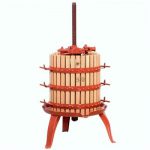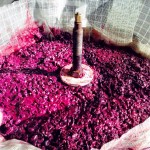What size wine press do I need?
When deciding on what size press you need, ask yourself the following questions.
- How much do I have to press?
- How much can I press at once with the given size of the wine press?
- How long will each press cycle take?
As with the crushing/destemming part of winemaking (and pretty much every other part of winemaking for that matter), the setup and cleanup will represent a significant portion of the day, so you don’t want to plan on spending 8 hours presssing unless you feel like working a 12 hour day. In general you want to be able to get through the entire lot of wine or grapes in about 5 hours.
Keep in mind that when you’re pressing must it will be between 30% and 35% solids. As you fill the press most of the liquid will flow right through and out referred to as free run wine/juice. So the volume of the press is going to correspond to the volume of solids that need to be pressed. For example, if you have 100 gal of fermented must to press, that only corresponds to about 35 gals worth of solids. To press 35 gals of solids through the 40L bladder press (10.6 gal) you would need to run about 3 press cycles in order to get the job done. If you can run a full press cycle on the 40L bladder press in about 45 minutes – which, as it happens, you can – then this press will totally do the trick.
Now seems like a good time to define what we mean by “press cycle.” A full press cycle consists of filling the press, pressing, emptying the press and cleaning and sanitizing it for the next run. Now that you understand the press cycle, its time to figure out which press is right for you.
Keep in mind that times for running press cycles do vary based on the your equipment set up, amount of helpers you have, practice, preparation, and level of expertise. The two most time consuming parts of the process are 1) filling the press, and 2) actually pressing. With the bladder press this essentially consists of waiting for the bladder to fill…
Whole Grape To Must
It can vary but for most reds, we can expect that a ton of fresh grapes (2,000 lbs) will yield about 210-240 gallons of must which in turn yields about 120-130 gallons of finished wine. The variation comes from cluster size, stem size and ratio, amount of shatter, open vs. closed clusters, berry size, skin thickness, number of seeds, press pressure, etc.
Cage Size To Cage In Liters To Cage In Gallons
| Cage Size | Cage in Liters | Cage in Gallons |
|---|---|---|
| 15 | 5 | 1.3 |
| 20 | 10 | 2.6 |
| 25 | 20 | 5.28 |
| 30 | 30 | 7.92 |
| 35 | 50 | 13.20 |
| 40 | 70 | 18.5 |
| 45 | 85 | 22.45 |
| 50 | 130 | 34.34 |
| 55 | 170 | 44.90 |
| 60 | 220 | 58 |
| 70 | 330 | 87 |
| 80 | 550 | 145 |
Using these estimates:
2,000 lbs of whole grape times .1125 = 225 lbs of must and juice times .35 = 78.75 lbs of solid must
So for example, a 70 liter press will press 87 pounds of solid must in one press so it could do around 2,000 lbs of whole grape that was 225 lbs of must and juice.
Now that you know how to size up your press, check out our posts about choosing your style of wine press, using rice hulls at press, and our wine pressing video.
How to Pick Your Style of Press
Using Rice Hulls While Pressing Your Wine
For more information and pricing on wine presses offered at MWG please emal sales@juicegrape.com
How to Pick a Press
How to Pick a Press
Which kind is right for you?
One of the most visually iconic and useful tools in winemaking is the wine press. It is the device that will separate the solids and skins from the precious juice or fermented wine. There are a couple different kinds you have to choose from, though they are at their core the same in that they use pressure to push hard against the skins to extract the remaining juice or wine that has not already become separated from the skins.
But upon investing in a wine press, how does one select a size and style? Here are some tips on selecting your first wine press:
Picking a Style
There is more than one way to press a grape! For home winemakers, there are two main styles of wine press that you can choose from: ratchet press or a bladder press.
- A ratchet press often has wooden sides and lid that hold in the grape must with a steel center rod and bottom juice tray. The grapes are loaded into the center of the press and large blocks are stacked on top of make up any lost volume. Then the lid is ratcheted down, applying vertical pressure from the top down upon the grapes. This style of press does an excellent job with extraction. The user must be careful not to exert too much pressure on the must as they are liable to crack seeds, which can release bitterness into the wine.
- A bladder press is similar in shape to a ratchet press but operates differently. Bladder presses have metal sides and lids to hold in the grape must along with the traditional metal bottom. They work via water pressure. Simply attach a garden hose to the inlet valve and the water will inflate a center bladder which exerts horizontal pressure against the grape must. This style of press exerts more gentle and even pressure to the grape must. The press must be filled up to the top to avoid “mushrooming” and bursting the center bladder.
Considerations
Choosing a reasonable size
When selecting a new press, the size options can be overwhelming. There are many different sizes of press, often measured in liters. Always take into account the must volume versus your end produced volume. If you anticipate to make 10 gallons of finished wine, you should anticipate on having 12-13 gallons of must, as the skins take up an additional 20% of the volume. You can always fill the press multiple times, but you should average at least an hour per press fill. Rather than do a huge load and then a much smaller one, it is preferable to split up each load so they will be pressed in roughly equal amounts. This will aid in giving the pressed juices/wines more uniformity.
Will your production size increase over time?
Also factor in the possibility of growth when selecting a press size. Winemaking is contagious and you may want to increase your batch size when you begin to drink your delicious results! It’s often wise to purchase a slightly larger ratchet press to accommodate for growth. If you purchase a slightly larger bladder press than what you may currently have for must, you can add rice hulls to the must to increase volume to properly inflate your bladder.
Other considerations
If you’re not a “sanitation is key” winemaker (and hopefully you are!) then a ratchet press may not necessarily be the best of these two choices. Since wood is porous, if you don’t remain cleanly every step of the way, then you may find yourself dealing with some very unwanted spoilage bacteria down the road. Getting a stainless steel bladder press will make it easier for you to be certain that every surface is completely cleaned and sanitized both pre- and post- use.
A wine press is a fundamental tool in home winemaking. It can dramatically increase your yield and quality. Knowledgeable staff at Musto Wine Grape can help you pick out the press that is the right fit for you!
Bring on the Bordeaux! – A Home Wine Making Experience (6)
And we are ready to go! First, we need to sanitize the press. We don’t want any gross microbes to get into our fabulous wine. Second, we shrink wrap the press to make sure the juice doesn’t squirt out at us. Third, we transfer the must into the press and let the press do it’s thing. Finally, we transfer the juice from the press to the stainless steel tank where we will be aging the wine until we decide to barrel age or add more oak additives.
You can see all the tubes attached to the press above. This is because we decided to use a bladder press. Bladder press’s are easy to use and don’t press the must too much. If you press too hard you run the risk of breaking the seeds and releasing astringent flavors. The bladder press has a happy medium of extracting optimal juice while maintaining the quality of the juice.


And now we wait… Thanks again for stopping by. Next time we will rack our wine. Stay tuned!
Side Note: Don’t Press in November, It’s Cold!!!!














Recent Comments